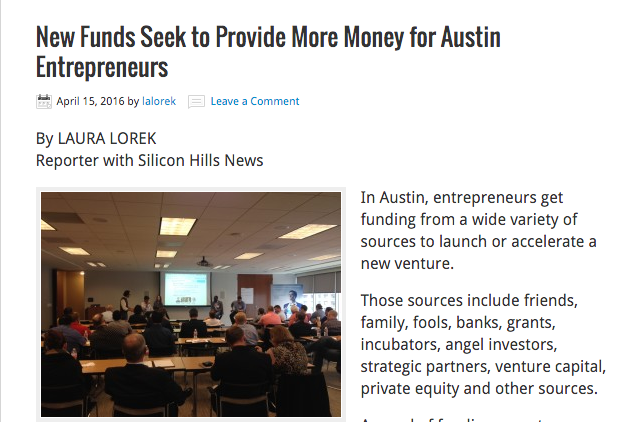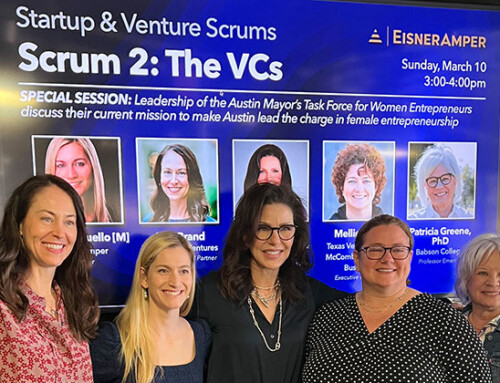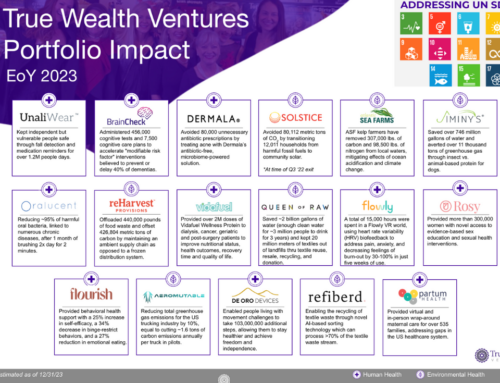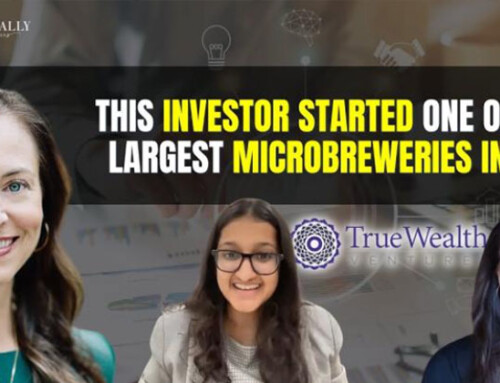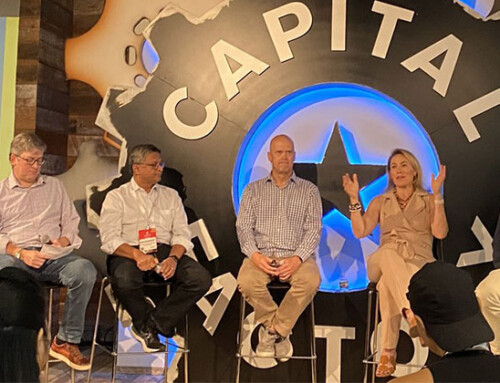This article originally appeared on Silicon Hills
In Austin, entrepreneurs get funding from a wide variety of sources to launch or accelerate a new venture.
Those sources include friends, family, fools, banks, grants, incubators, angel investors, strategic partners, venture capital, private equity and other sources.
A panel of funding experts gathered Wednesday afternoon in an 11th floor conference room at the Frost Bank Tower to talk with entrepreneurs about where startups should seek funding for their ventures. The event, sponsored by Texas State Small Business Development Center, was the second part in a two-part discussion on funding startups. Last week, a different panel talked about why entrepreneurs should seek funding.
Paul O’Brien, founder of Accelerate Texas, moderated both of the discussions.
The latest panelists included Krishna Srinivasan, general partner, Live Oak Venture Partners, Sara T. Brand, founding partner, True Wealth Ventures, James Earl Brown II, founder, Arena Growth Partners and Orlando Castillo, senior lender, Able Lending.
LiveOak Venture Partners closed on its $100 million fund in 2014. Srinivasan and his two founding partners came from Austin Ventures. They saw an unmet need for seed stage and Series A funding for Texas-based entrepreneurs.
At True Wealth Ventures, Brand and her venture partner, Kerry Rupp, invest in women-led seed-stage startups in consumer health and sustainable products and technologies. They expect to have a $20 million fund. They plan to make 10 to 12 early seed stage investments ranging in size from $250,000 to $500,000, she said.
“Our thesis is a financial one that more gender diverse teams derive better financial performance based on a number of different studies,” Brand said. She also founded 512 Brewing Company with her husband, Kevin.
Arena Growth Partners is also raising a new fund. It is raising a $50 million fund focused on Information Technology and Information Technology enabled devices, Brown said. He has spent the last 20 plus years in the venture capital business with JP Morgan Capital, Polaris Partners and most recently he served as director of entrepreneurship at the University of Texas at Austin.
During his time in Austin, Brown has identified big gaps in the entrepreneurial ecosystem in funding and leadership talent. His firm is focused on encouraging people to think bigger and helping them get there, Brown said.
Able Lending focuses on debt financing, said Castillo. He joined the startup two years ago. It will do between 400 to 500 transactions this year, he said. The company is the lowest lender in the U.S. that is not a bank with an average rate of 10.7 percent on loans, he said.
O’Brien asked the panelists how they managed deal flow.
Able’s deal flow comes from outbound calls, banks, connections with the Small Business Development Center and a lot has come from word of mouth advertising, Castillo said.
True Wealth Venture gets deal flow from judging pitch competitions, mentors at Capital Factory, Brand said.
Of all the venture capital backed companies only three percent are women led, Brand said. It’s tough to find deals through traditional channels. So True Wealth Ventures is doing speaking engagements and social media outreach to find them, Brand said.
“One of the approaches Arena has taken is we’re trying to be helpful,” Brown said. The firm focuses on taking the servant leadership approach, he said.
LiveOak Venture Partners encourages entrepreneurs to submit business plans via email to plans@liveoakvp.com, Srinivasan said.
“Contrary to somewhat public perception, the partners at LiveOak, we are as eager to meet and interact with entrepreneurs locally as they are to meet and interact with us,” Srinivasan said.
Out of the 15 investments LiveOak has made, two of those investments came through email, Srinivasan said.
Entrepreneurs that submit an email plan also get a reply from one of the partners at LiveOak and if it’s within its investment focus in Texas, the entrepreneur is likely to get a meeting with one of the partners lasting from 30 minutes to an hour, Srinivasan said.
LiveOak meets with more than 300 companies a year, Srinivasan said.
Brown with Arena Growth Ventures, said he would challenge entrepreneurs to think about what they want to be when they grow up and how many nos are they willing to take and what are they willing to learn from them. And what do they want out of a partner.
“One of the challenges in Austin is there is not enough of us,” Brown said.
Austin got four to five new venture funds just because Austin Ventures went away, he said.
Entrepreneurs in Austin don’t get a chance to get enough nos, Brown said. They can meet with six venture firms here and then they’re done, he said. In Silicon Valley, they can meet with six venture firms in one day, six the next day and so on, he said.
“By the time you get to the 50th person who says yes, part of the reason is because your pitch looks fundamentally different than the first time you gave it and the tenth time you gave it and the 20th time you gave it,” Brown said. “So unfortunately you don’t get that opportunity here.”
There’s been a tremendous improvement in the market for early stage venture capital in Austin during the last few years, said Srinivasan. There’s about 20 early stage companies that received funding in the last three years, he said. That’s a huge improvement from the lack of early stage funding between 2009 to 2012, he said.
In Austin, angel investors are different than in Boston and the Valley, said Brown.
“In Austin, you have a lot of very smart people with disposable income that don’t know a whole lot about technology,” he said.
In the Valley or Boston, an angel investor is a two to three plus successful serial entrepreneur who has been there and done that in the space you are trying to start a company in and they get it, Brown said.
“You don’t have to evangelize in the space, they get it,” he said. They can introduce you to experienced employees and customers in your industry, he said.
“Here you don’t get that,” he said. “Here it can be a beauty contest. So what that means is that if you can convince them to invest in something that they don’t know but they are interested in you can get that capital.”
There’s a ton of capital in Austin where an entrepreneur can raise up to $1.5 million from people who don’t know a lot about the technology or industry and can’t help, he said.
The panelists also talked about syndicating deals. That’s one way to make the entire ecosystem thrive and grow through cooperation, collaboration and syndication, Srinivasan said.
One of the best things about Austin is it is a friendlier place – there’s this rare opportunity in Austin for more cross-functional innovation than there is in other cities, Brand said.
A key supply and demand imbalance exists in Austin today, Brown said. Entrepreneurship in Austin is at an all-time high, Brown said. At the same time, access to capital – institutional or otherwise is at an all-time low, he said. So there’s frustration in that tension and that’s understandable, he said. New funds are springing up to fill the gap but it’s taking time, he said. And entrepreneurs don’t have patience, he said.

